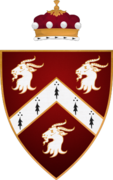Busby Hall
Busby Hallis aGrade II* listedCountry House inLittle Busby,North Yorkshire,England, close to the village ofCarlton-in-Cleveland.The house and parkland sits within theNorth York Moors National Park.[1]
The house is perhaps best known as the inspiration for Groby Hall inParade's End,a novel byFord Madox Ford.[2]
History
[edit]
Busby Hall has been in the possession of theMarwoodfamily since 1587.[3]The current building was constructed in 1764 after a devastating fire destroyed a much earlier building.[4]It is known that plans for a grander building were prepared by the preeminentneo-classicalarchitectJohn Carr of Yorkbut were later abandoned.[5]The constructed design was by Robert Corney.[6]It has been remarked that the design of the house appears to be earlier in style than was typical for the time, but the reason for this or why the plans of a more fashionable architect were not used is not clear.[7]The house sits in the centre of a 700-acre parkland with a number of other listed buildings. These include the Grade II stable block located to the north and a Grade II* walled garden to the south east of the Hall.[8]
There are several acres of gardens which surround the hall, which once contained a chestnut tree reputed to be the largest in England.[9]
The Marwoods of Busby Hall
[edit]
The Marwoods had held lands in this part ofNorth Yorkshirefor a number of years by the time Busby Hall became their principle seat in the16th Century.[10]They were granted the hereditary title ofBaronet of Little Busbyin 1660.[11]The Marwood family descended fromEdward III of Englandand are related, through marriage, to many prominent aristocratic families including theLascelles,Wentworths,Van Straubenzees and theEarls of Holderness.[12]Notable family members included Sir George Marwood and Sir Henry Marwood who both respectively served asHigh Sheriffs of YorkshireandMembers of Parliamentfor Northallerton. Arthur Pierson Marwood, a friend ofFord Madox Ford,is likely to be the inspiration for Christopher Tietjens in the novelParade's End.[13]
Inspiration for Groby Hall inParade's End
[edit]Considered one of the great literary works of the 20th century,Parade's Enddetails the story of an ancient landed family from Yorkshire.[14]It is purported that Madox Ford based the novel on both his then friend Arthur, a scion of the Marwood family, and their home Busby Hall.[15]Sir William Marwood,Arthur's elder brother is similarly considered the inspiration for Mark Tietjens.[16]There is are several piece of evidence for this. First, it is noted that the parities between Arthur Marwood and Christopher Tietjens are highly apparent, Marwood and Tietjens both being talented economists and regarded for theirstoicand 'honourable' characteristics.[17]It is also evident that Busby Hall shares many similarities with Tietjen's Groby Hall, including the location. In the novel, several references are made to 'Groby Great Tree' which is thought to be inspired by the famed chestnut tree.[18]It is also case that Busby was let for a period of time as also occurs at the end of the novel when the Groby Great Tree is symbolically felled by the brash new tenant.[19]The similarities of the locations, characters and events of the book proved sensitive for Marwood who permanently broke off contact with Madox Ford.[17]
References
[edit]- ^Archives, The National."The Discovery Service".discovery.nationalarchives.gov.uk.Retrieved21 April2020.
- ^"Centenary leads to renewed interest in wartime writer | Media centre | Teesside University".tees.ac.uk.Retrieved21 April2020.
- ^"MARWOOD, Sir Henry, 2nd Bt. (c.1635-1725), of Little Busby, Stokesley, Yorks. | History of Parliament Online".histparl.ac.uk.Retrieved21 April2020.
- ^Historic England."BUSBY HALL, Little Busby (1151369)".National Heritage List for England.Retrieved21 April2020.
- ^Fairfax-Blakeborough, John (1912).Life in a Yorkshire village (with special reference to the evolution, customs, folklore and legends of Carlton-in-Cleveland, this village being taken as a type).University of California Libraries. Stockton-on-Tees [England]: The Yorkshire publishing co. [etc., etc.]
- ^British Listed Buildings."Busby Hall, Little Busby, North Yorkshire".britishlistedbuildings.co.uk.Archivedfrom the original on 7 July 2020.Retrieved21 April2020.
- ^"Parishes: Stokesley | British History Online".british-history.ac.uk.Retrieved21 April2020.
- ^Stuff, Good."Walled Garden to South East of Busby Hall, Little Busby, North Yorkshire".britishlistedbuildings.co.uk.Retrieved21 April2020.
- ^Robson, Dave (23 August 2012)."BBC2 TV mini-series Parade's End has roots on Teesside".gazettelive.Retrieved21 April2020.
- ^"Busby Hall Archives".archivesunlocked.northyorks.gov.uk.Retrieved21 April2020.
- ^Dugdale, William; Clay, John William (1899).Dugdale's Visitation of Yorkshire, with additions.David O. McKay Library Brigham Young University-Idaho. Exeter: W. Pollard & Co.
- ^Ruvigny and Raineval, Melville Amadeus Henry Douglas Heddle de La Caillemotte de Massue de Ruvigny (1905).The Plantagenet roll of the blood royal; being a complete table of all the descendants now living of Edward III, King of England.Allen County Public Library Genealogy Center. London, and Edinburgh, T.C. & E.C. Jack.
- ^The Oxford reader's companion to Conrad.Knowles, Owen., Moore, Gene M., 1948-. Oxford: Oxford University Press. 2000.ISBN0-19-866214-9.OCLC43070127.
{{cite book}}:CS1 maint: others (link) - ^Ray, Martin (2007).Joseph Conrad: memories and impressions: an annotated bibliography.Amsterdam: Rodopi.ISBN978-1-4356-1290-7.OCLC649903363.
- ^Saint-Amour, Paul K. (2015).Tense future: modernism, total war, encyclopedic form.Oxford.ISBN978-0-19-020094-7.OCLC890377271.
{{cite book}}:CS1 maint: location missing publisher (link) - ^Mizener, Arthur. (1985).The saddest story: a biography of Ford Madox Ford(Repr ed.). New York: Carroll & Graf.ISBN0-88184-187-0.OCLC63480284.
- ^abMoser, Thomas C. (14 July 2014).The life in the fiction of Ford Madox Ford.Princeton, New Jersey.ISBN978-1-4008-5620-6.OCLC889251083.
{{cite book}}:CS1 maint: location missing publisher (link) - ^Saunders, Max (2012).Ford Madox Ford: a dual life.Oxford: Oxford University Press.ISBN978-0-19-966834-2.OCLC819516103.
- ^Rintoul, M. C. (1993).Dictionary of real people and places in fiction.London: Routledge.ISBN0-415-05999-2.OCLC27212714.


